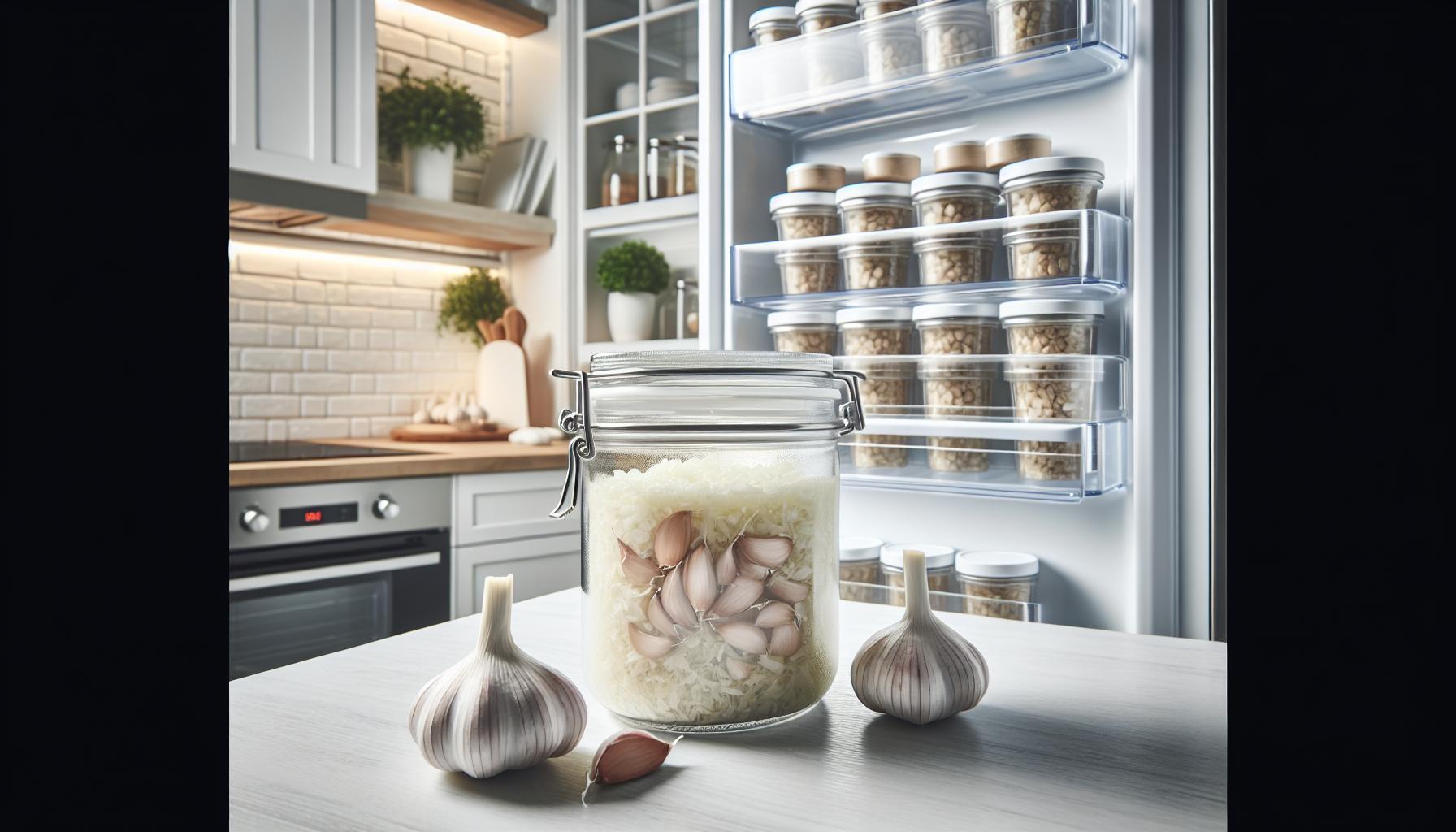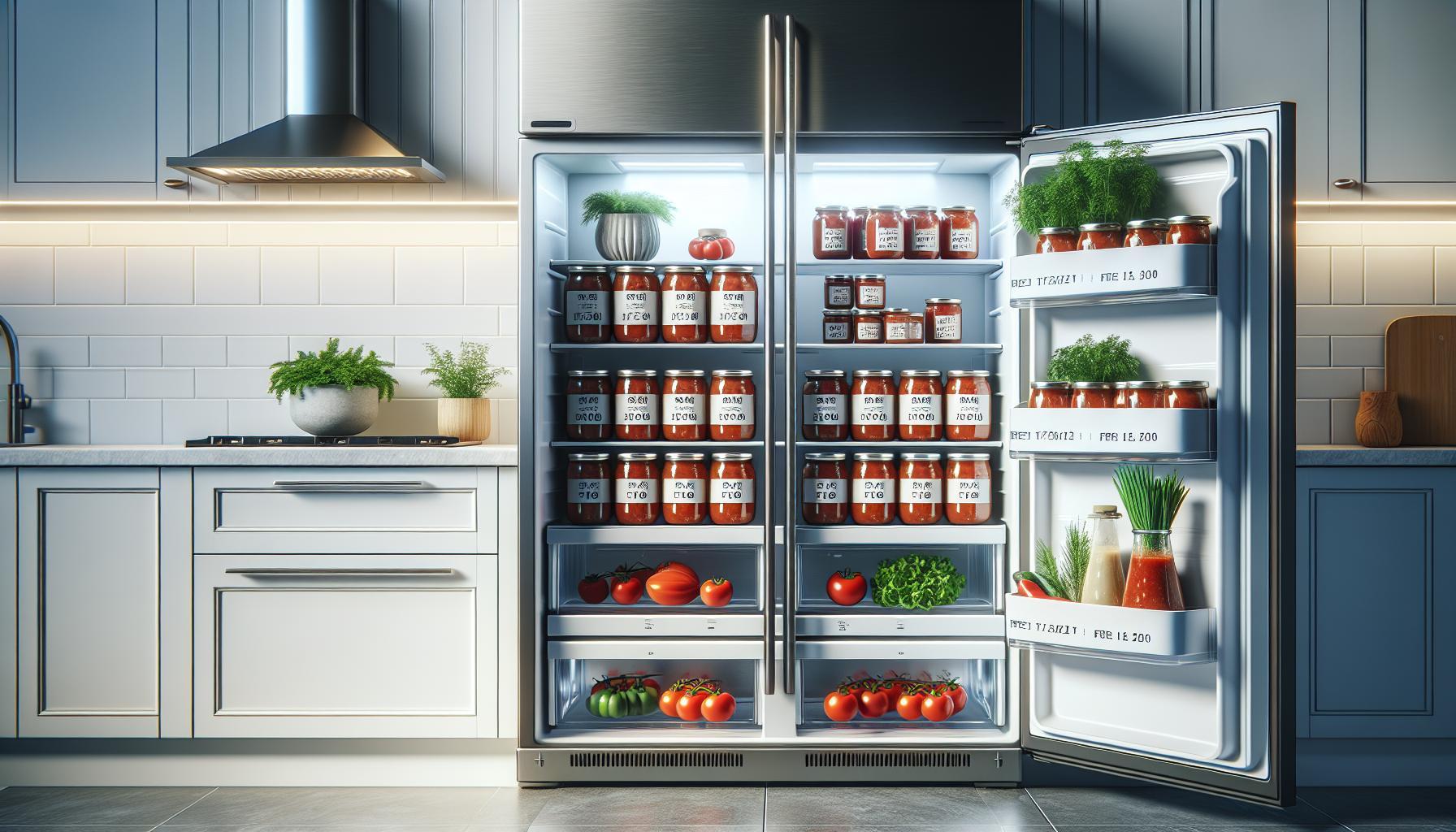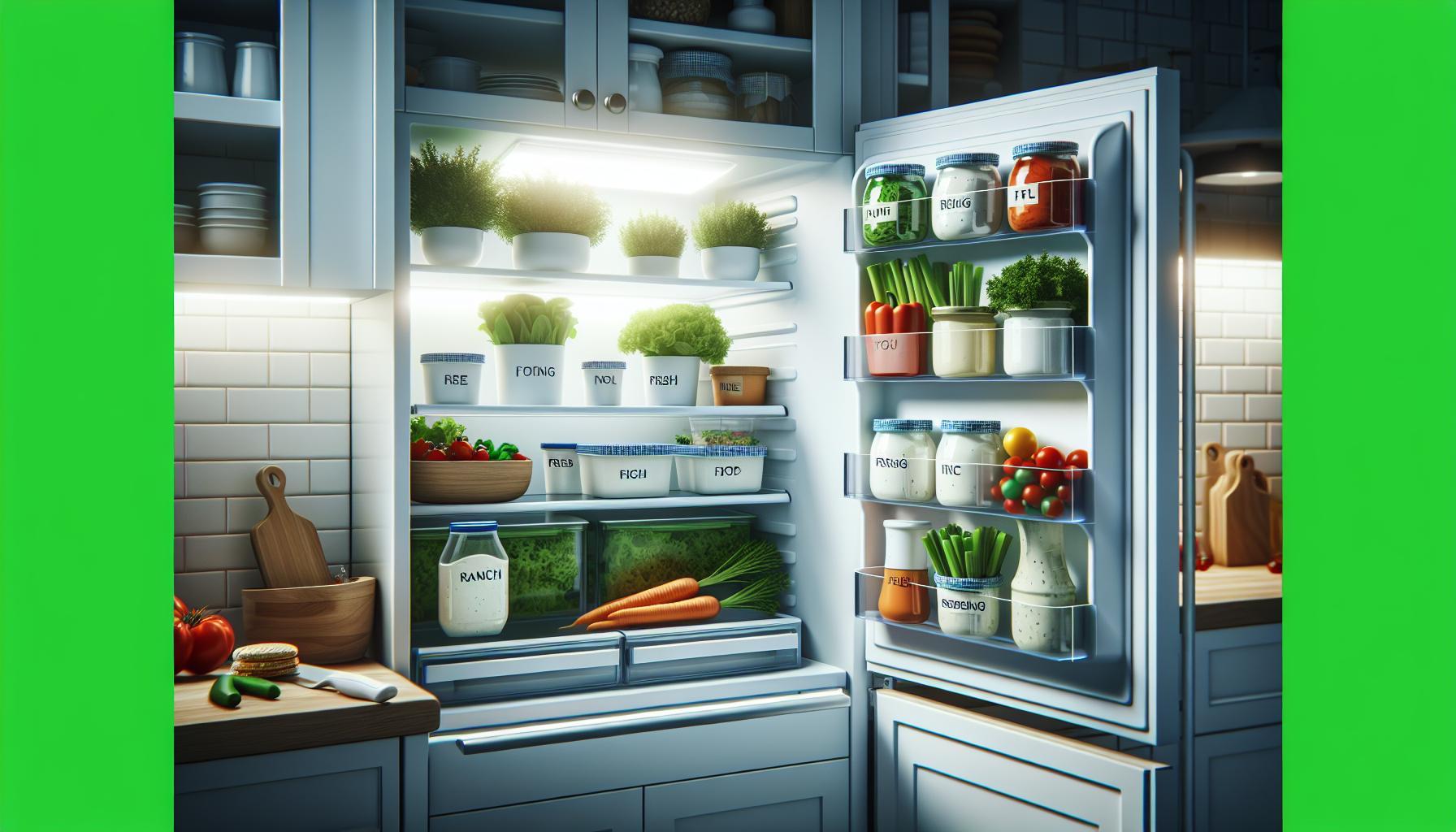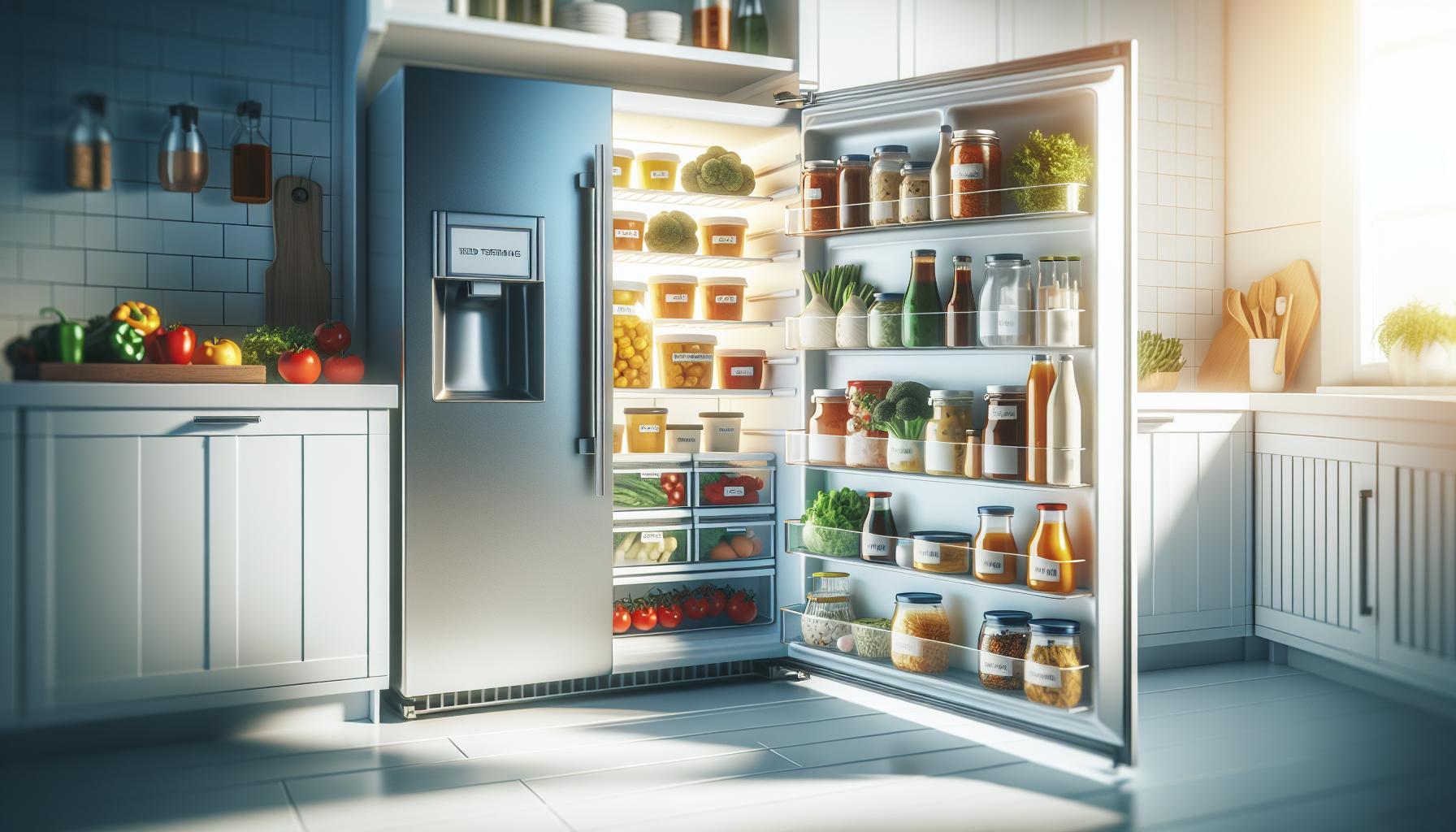Minced garlic is a beloved staple in many kitchens, bringing depth and flavor to countless dishes. However, it’s essential to know how long this aromatic ingredient lasts in the fridge to prevent waste and ensure food safety. Improper storage can lead to spoilage, diminishing its taste and potentially causing health risks.
Have you ever found a jar of minced garlic in the back of your fridge, only to wonder if it’s still good to use? You’re not alone. With the right knowledge, you can safely enjoy the vibrant flavors of minced garlic without the worry of it going bad unexpectedly. In this guide, we’ll explore storage tips, shelf life, and practical advice to help you make the most of this versatile ingredient while keeping your meals delicious and safe. Prepare to learn everything you need to know to manage your minced garlic effectively and avoid unnecessary waste!
How Long Does Minced Garlic Last in the Fridge?
Minced garlic is a kitchen staple appreciated for its robust flavor and versatility, but knowing how long it lasts in the fridge can help you avoid waste and ensure you’re using it at its best. When stored properly in an airtight container, freshly minced garlic can typically last about 1 week in the refrigerator. However, the shelf life varies depending on several factors such as freshness at the time of purchase and storage conditions.
To maximize its longevity, ensure you store minced garlic in a cool part of the refrigerator, ideally in a glass or plastic container with a secure lid to prevent exposure to air, which can lead to spoilage. If you notice any discoloration, a change in texture, or a sour smell, it’s best to err on the side of caution and discard it. Maintaining a clean environment and using clean utensils when handling minced garlic can also help prevent contamination and extend its freshness.
Understanding how to properly label your storage container can assist in tracking the freshness of your minced garlic. Consider labeling with the date of preparation, allowing you to easily keep track of how long it has been stored. By following these guidelines, you can enjoy the rich flavor of minced garlic in your dishes without the worry of spoilage.
Ideal Storage Conditions for Minced Garlic
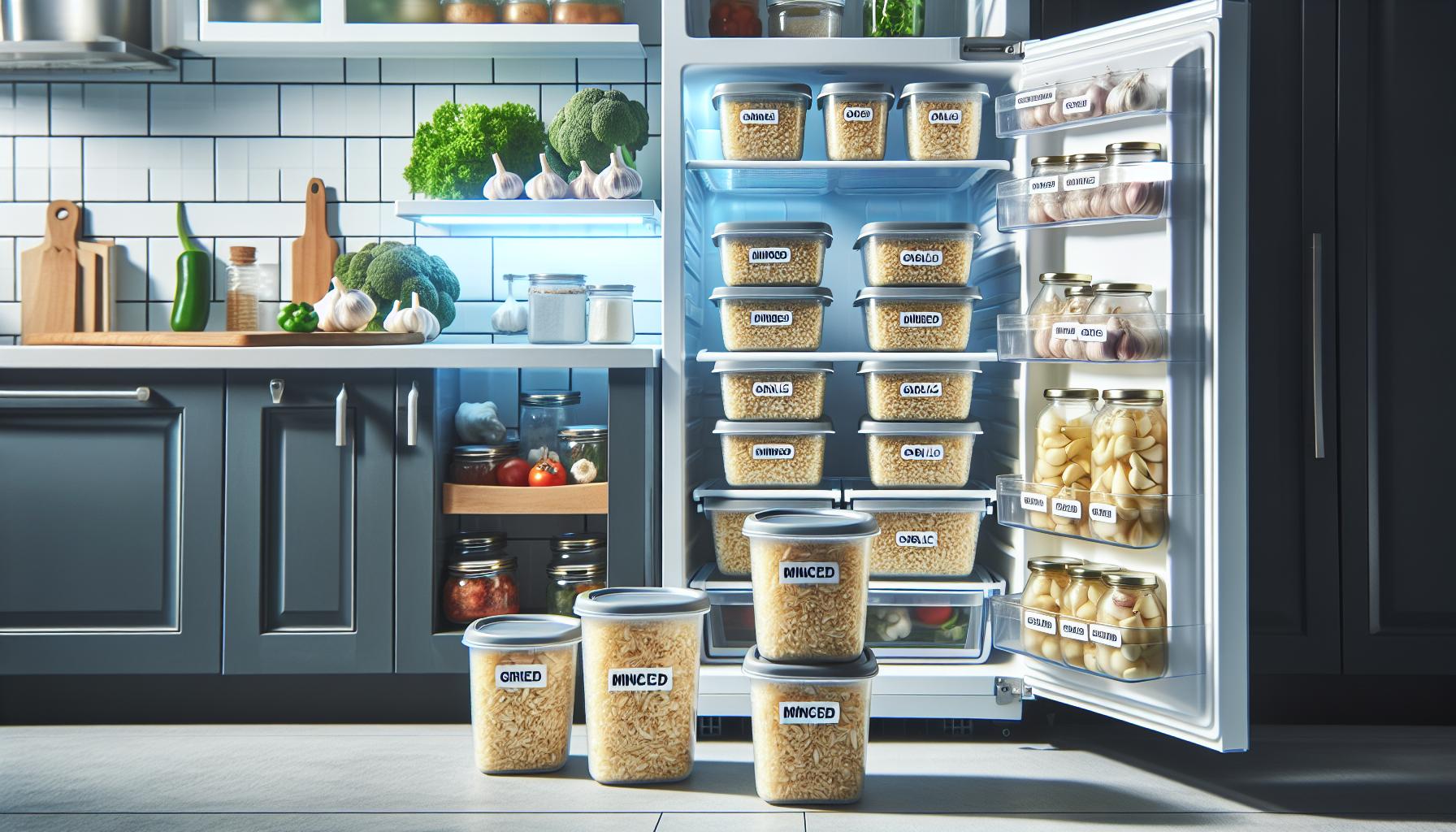
Storing minced garlic correctly can significantly enhance its longevity and flavor profile, making it a more reliable ingredient in your cooking repertoire. The ideal storage conditions begin with temperature; garlic should always be kept in the refrigerator, as cooler environments help inhibit bacterial growth and prolong freshness. A consistent temperature is crucial; aim to place minced garlic in the main compartment of the fridge rather than the door, where fluctuating temperatures may compromise its quality.
Utilizing an airtight container is essential to prevent exposure to air and moisture, both of which can accelerate spoilage. Glass or high-quality plastic containers with tight-fitting lids are ideal choices. Additionally, ensure the storage container is clean and dry before transferring the freshly minced garlic to minimize contamination risks. For optimal organization, consider labeling the container with the date of preparation. This will help you keep track of freshness and ensure that you use it within its optimal shelf life, typically around one week.
To further optimize storage, keep the minced garlic away from strong odors, as garlic can absorb scents from surrounding foods. Storing it in a designated shelf away from pungent items will aid in maintaining its distinctive flavor. Lastly, remember to use clean utensils whenever you scoop out minced garlic; this practice not only preserves the garlic’s integrity but also helps prevent introducing bacteria that could lead to spoilage. By adhering to these guidelines, you’ll ensure that your minced garlic remains a vibrant and flavorful addition to your culinary creations.
Signs That Minced Garlic Has Gone Bad

Minced garlic is a staple in many kitchens, prized for its bold flavor and versatility. However, like any fresh ingredient, it has a limited shelf life, and recognizing the signs that it has gone bad is crucial for both health and culinary satisfaction. When stored properly in the fridge, minced garlic can last about one week, but various factors can lead to quicker spoilage. Observing the garlic closely can help ensure you avoid using outdated or spoiled products.
One of the first signs that minced garlic has exceeded its prime is a noticeable change in color. Fresh minced garlic is typically a light, creamy white. If you begin to see darkened pieces or a yellow tint, it’s wise to exercise caution. Additionally, a potent and pleasant aroma characterizes fresh minced garlic, so if the garlic begins to smell sour or off, it’s a clear indication that it has started to spoil.
Texture changes are another key indicator to watch for. Fresh minced garlic should be moist but not slimy. If you notice any slime or excessive moisture accumulation in the container, it suggests bacterial growth is at play, and you should discard the garlic immediately. Furthermore, if you find any signs of mold or a fuzzy appearance, do not attempt to salvage it-moldy garlic poses significant health risks and should be completely thrown away.
Lastly, pay attention to the taste. If you sample a small amount and detect a bitter or sour flavor instead of the expected pungent kick, it’s best to err on the side of caution and dispose of the garlic. By being vigilant and aware of these signs, you can ensure that the minced garlic you incorporate into your dishes remains fresh, enhancing your meals rather than compromising them.
How to Properly Store Minced Garlic

Minced garlic is a culinary powerhouse, beloved for its robust flavor and convenience in enhancing dishes. To maximize its freshness and flavor while preventing waste, proper storage techniques are essential. Minced garlic should ideally be stored in an airtight container. This minimizes exposure to air and moisture, both of which accelerate spoilage and may introduce unwanted bacteria. Glass jars with tight-fitting lids or high-quality plastic containers work well, ensuring that the garlic remains sealed away from fluctuating temperatures and humidity.
For optimal freshness, place the container in the refrigerator. The cold environment slows down the growth of bacteria, safeguarding the minced garlic for about one week. Ensure that the garlic is kept away from other strong-smelling foods, as it can absorb odors easily. If you’re preparing large batches of minced garlic, consider portioning it into smaller containers. This way, you only expose a small amount at a time, reducing the risk of spoilage for the entire batch once opened.
Another effective method to prolong the shelf life of minced garlic is to incorporate oil. Blending minced garlic with oil creates a flavorful paste that not only enhances meals but also extends its longevity, as the oil acts as a barrier against bacteria. Store this mixture in the freezer for extended use; it can keep for several months. If utilizing this approach, always use clean utensils to scoop out portions to prevent contamination. By following these careful storage practices, you can enjoy the bold flavor of minced garlic without the worry of waste or spoilage.
Tips for Preventing Waste of Minced Garlic
To make the most of minced garlic in your kitchen, it’s essential to employ strategies that prevent waste and extend its usability. One surefire way to minimize waste is by preparing only what you need. When using fresh garlic, consider mincing just enough for your current recipes rather than a large batch. This practice ensures you’re using freshly minced garlic at its peak flavor while reducing the chance of spoilage. If larger quantities are necessary, you can portion minced garlic into smaller containers, allowing you to thaw or open only what you need at a time.
Another effective strategy is to combine minced garlic with oil. This not only enhances the flavor for future dishes but also extends the garlic’s shelf life. Simply mix minced garlic with a neutral oil, such as olive or vegetable oil, and store it in an airtight container in the refrigerator. This garlic-oil mixture can last for up to a month in the fridge and can even be frozen for extended use, making it a versatile addition to your culinary toolkit.
It’s also vital to monitor for any signs of spoilage. Regularly check your minced garlic for changes in color, texture, or odor. If you notice any sour smell or mold, it’s best to discard it. Additionally, clear labeling can significantly help in preventing waste; mark containers with dates to keep track of their freshness. By implementing these practices, you can enjoy the rich flavor of minced garlic while keeping waste to an absolute minimum.
Can You Freeze Minced Garlic?
Freezing minced garlic is a practical solution for extending its shelf life while maintaining its robust flavor. When properly frozen, minced garlic can last for several months, allowing you to avoid the waste that often accompanies fresh garlic. To freeze minced garlic, it is essential to follow a few straightforward steps to ensure optimal quality and safety.
Start by placing the minced garlic in ice cube trays or small, airtight freezer bags. Pop the trays into the freezer, allowing the garlic to freeze solid. Once frozen, transfer the garlic cubes to a labeled, airtight container or bag, ensuring to remove as much air as possible before sealing. This method not only preserves the garlic but also makes it convenient to use; simply take out the desired amount when you need it for a recipe.
When you’re ready to use frozen minced garlic, there’s no need to thaw it. You can add it directly to your cooking as the dish simmers. However, if you prefer working with thawed garlic, leave the cubes in the refrigerator for several hours or overnight, or place them in a bowl at room temperature until they soften. It’s important to note that freezing may slightly alter the texture of minced garlic, making it more mushy than fresh, but the flavor remains rich and potent for culinary applications.
Additionally, incorporating frozen minced garlic into dishes like soups, sauces, and stir-fries allows for seamless flavor enhancement without the time and hassle of fresh prep. By adopting this freezing technique, you can ensure that your minced garlic is always on hand, ready to elevate your culinary creations while minimizing waste.
Using Leftover Minced Garlic Safely
Using leftover minced garlic can enhance your dishes significantly, but safety should always be your top priority. Once opened, minced garlic has a relatively short lifespan, particularly when stored in the refrigerator. Ideally, any leftover minced garlic should be kept in an airtight container, where it can retain its flavor and stay fresh for about one week. Always check for any changes in color or odor before use, as these are early indicators that it may not be safe to consume.
If you find yourself with more minced garlic than you can use in a week, consider several creative ways to safely utilize leftovers. For instance, incorporating minced garlic into sauces and marinades can add depth to your dishes. When making salad dressings or dips, mixing minced garlic can provide an extra kick, enhancing both flavor and nutrition. For soups or stews, minced garlic not only elevates the taste but also infuses the dish with its health benefits.
In terms of food safety, ensure that your utensils and surfaces are clean when handling minced garlic to prevent any bacterial contamination. After using some from the jar, it’s best to refrigerate any remaining minced garlic quickly. If you notice any signs of spoilage, like a strong sour smell or unusual consistency, discard it immediately to avoid any health risks. Planning and using your minced garlic strategically can minimize waste while maximizing flavor in your meals.
The Best Recipes to Use Up Minced Garlic
There’s no need to let leftover minced garlic go to waste. This flavorful ingredient can enhance a variety of dishes while helping you reduce food waste. Here are some delicious and practical ways to incorporate minced garlic into your meals before it loses freshness.
One of the simplest ways to use up minced garlic is by adding it to meat marinades. Combine minced garlic with olive oil, herbs, and spices to create a savory marinade for chicken, beef, or pork. The garlic infuses the meat with flavor, making it more delicious when grilled or roasted. You can also use minced garlic in stir-fries; simply sauté it in oil along with your choice of vegetables and protein for a quick and tasty meal.
Another great use for leftover minced garlic is in sauces and dressings. Whip up a quick garlic vinaigrette by mixing minced garlic with vinegar, mustard, and oil. Toss it over a fresh salad or use it as a dip for vegetables. Additionally, consider incorporating minced garlic into soups and stews. It adds depth and richness to the broth, enhancing the overall flavor of the dish.
If you’re feeling adventurous, try garlic-infused oil. Gently heat olive oil in a pan and add minced garlic until it’s fragrant. This oil can then be drizzled over pasta, pizza, or roasted vegetables for an aromatic finishing touch. You can also add minced garlic to doughs and batters for breads or savory muffins, providing a unique twist to traditional recipes.
By incorporating these easy recipes into your cooking routine, not only will you prevent waste, but you’ll also elevate your dishes with the wonderful flavor of garlic. Remember to store the remaining minced garlic properly in an airtight container in the fridge and check for any signs of spoilage before use, ensuring it stays fresh and safe for your culinary creations.
The Shelf Life of Store-Bought vs. Homemade Minced Garlic
Store-bought minced garlic typically has a longer shelf life than homemade options due to preservatives and packaging methods designed to prolong freshness. Generally, if stored properly in the refrigerator, unopened store-bought minced garlic can last up to 3 to 4 months past its expiration date. Once opened, you can expect it to remain safe and flavorful for around 1 month. However, always check for any signs of spoilage before use.
Conversely, homemade minced garlic, which lacks the preservatives found in commercial products, has a much shorter lifespan. When made fresh, it can last about 1 week in the refrigerator if stored in an airtight container. For optimal freshness, it’s best to consume it within this week. If you find yourself with excess homemade minced garlic, consider preserving it by freezing, which can extend its usability for several months.
When comparing the two, it’s essential to note that the safety of minced garlic-whether store-bought or homemade-depends greatly on storage conditions. Always keep garlic away from moisture, ensure your containers are airtight, and monitor for signs of spoilage such as off-smells, discoloration, or mold. By being attentive to these factors, you can maximize the usage of both store-bought and homemade minced garlic in your culinary endeavors without risking waste.
Common Myths About Garlic Storage
Understanding the storage of garlic is essential, especially to avoid waste and ensure food safety. One common myth is that garlic can be stored indefinitely at room temperature. In reality, while whole garlic bulbs can be kept in a cool, dry place, once minced, it must be treated differently. Minced garlic, whether homemade or store-bought, requires refrigeration and has a limited lifespan due to the risk of bacterial growth, particularly if it’s not stored in an airtight container.
Another misconception is that all garlic products are the same in terms of shelf life. Store-bought minced garlic often contains preservatives that extend its freshness significantly longer than homemade versions. While unopened jars of commercial minced garlic can last several months past the expiration date, homemade minced garlic typically only lasts about a week when stored correctly in the fridge. This difference underscores the importance of understanding which type of minced garlic you have and how to store it properly.
Moreover, some people believe that storing minced garlic in oil is safe indefinitely. While this may enhance flavor, it poses a significant botulism risk if not handled correctly. Garlic-in-oil mixtures should always be refrigerated and used promptly, keeping in mind that the oil should ideally not exceed one week for maximum safety. By debunking these myths, individuals can make informed choices about how to store and utilize garlic, ensuring they enjoy its flavor without compromising on safety.
### Practical Storage Tips
To maximize the freshness of minced garlic and avoid waste, consider the following tips:
- Refrigerate immediately: Always store minced garlic in an airtight container in the refrigerator to limit exposure to air and moisture.
- Label and date: Keep track of when you opened or prepared garlic to ensure you use it within the recommended timeframe.
- Freeze for longer storage: If you have excess minced garlic, consider freezing it in small portions. This method can extend its shelf life for several months.
By adhering to these guidelines and dispelling common myths, you can confidently enjoy minced garlic, knowing how to store it safely and effectively.
Health Risks of Using Spoiled Minced Garlic
Using spoiled minced garlic, while it might seem harmless, can pose significant health risks. One of the most concerning dangers is the potential for botulism, a rare but severe illness caused by the bacteria Clostridium botulinum. This risk is particularly emphasized when garlic is stored improperly, such as in oil without adequate refrigeration. Botulism thrives in low-oxygen environments, like oil, when garlic is not handled carefully.
Another common concern is foodborne illness caused by other bacteria, such as Salmonella or E. coli. When minced garlic starts to spoil, it becomes an inviting environment for these pathogens. Signs of spoilage can include an off smell, discoloration, or mold growth. Consumption of spoiled garlic not only increases the risk of gastrointestinal distress but can lead to more severe health issues, especially for individuals with compromised immune systems, young children, or the elderly.
To prevent these health risks, it’s essential to follow proper storage practices for minced garlic. Always refrigerate garlic promptly and store it in a clean, airtight container. Additionally, if garlic has been stored for longer than recommended periods-typically a week for homemade and up to three months for frozen versions-it’s wise to err on the side of caution and discard it. This proactive approach ensures that you can enjoy the flavor and health benefits of garlic without the worry of contamination or spoilage-related illnesses.
Being informed about the safe storage of minced garlic not only helps keep your meals safe but also enhances your culinary experience. Always prioritize food safety and remember that when in doubt, it’s best to throw it out-your health is worth more than a little wasted garlic.
FAQ
Q: How can I tell if minced garlic is still good to use?
A: To determine if minced garlic is still good, check for discoloration, an off smell, or a change in texture. Fresh minced garlic should have a bright color and a strong aroma. If it looks brown or has a sour smell, it’s best to discard it. For more signs, refer to the section on signs of spoilage.
Q: Can minced garlic be stored in water?
A: Minced garlic should not be stored in water as it can promote bacterial growth. Instead, store it in an airtight container in the fridge. To keep it fresh, consider using olive oil or freezing it. For proper storage methods, refer to the “How to Properly Store Minced Garlic” section.
Q: What is the best way to prevent minced garlic from spoiling?
A: To prevent minced garlic from spoiling, seal it tightly in an airtight container and store it in the refrigerator. It’s also advisable to use it within a week of opening to minimize waste. For more tips, check the “Tips for Preventing Waste of Minced Garlic” section.
Q: Can I reuse leftover minced garlic after cooking?
A: You can reuse leftover minced garlic if it’s been cooked and stored properly. Keep it in an airtight container in the fridge and use it within three to four days. For safety tips, see the “Using Leftover Minced Garlic Safely” section.
Q: How long does homemade minced garlic last compared to store-bought?
A: Homemade minced garlic typically lasts about one week in the fridge, while store-bought varieties can last longer, depending on preservatives. Always check the packaging for specific expiration dates. Read more in “The Shelf Life of Store-Bought vs. Homemade Minced Garlic.”
Q: Is it safe to eat minced garlic after the expiration date?
A: Eating minced garlic after the expiration date is not recommended, as it can compromise safety and flavor. Always assess its condition and when in doubt, discard it. For health risks, refer to the “Health Risks of Using Spoiled Minced Garlic” section.
Q: Can I store minced garlic in the freezer?
A: Yes, you can freeze minced garlic to extend its shelf life. Portion it out in ice cube trays, then transfer the cubes to a freezer bag for easy use later. For freezing methods, see “Can You Freeze Minced Garlic?”
Q: What is the best way to defrost frozen minced garlic?
A: The best way to defrost frozen minced garlic is to transfer the cubes to the fridge and let them thaw overnight. You can also microwave them briefly if you need them quickly. For more tips, refer back to the section on freezing minced garlic.
Wrapping Up
To maximize the freshness and safety of your minced garlic, it’s essential to remember that it lasts about one week in the fridge when stored properly. Don’t let your culinary creations go to waste-by following the right storage tips, you can enjoy the rich flavor of garlic without any spoilage concerns. For effective preservation strategies, explore our articles on “Best Practices for Storing Fresh Herbs” and “How to Make Garlic Oil Safely” to enhance your kitchen skills even further.
Curious about more food storage tips? Subscribe to our newsletter for expert insights delivered straight to your inbox, or check out our delicious garlic-based recipes that make the most of your ingredients. Your culinary adventures are just beginning! Share your thoughts and experiences in the comments below, and keep exploring our site for more ways to elevate your cooking game.

